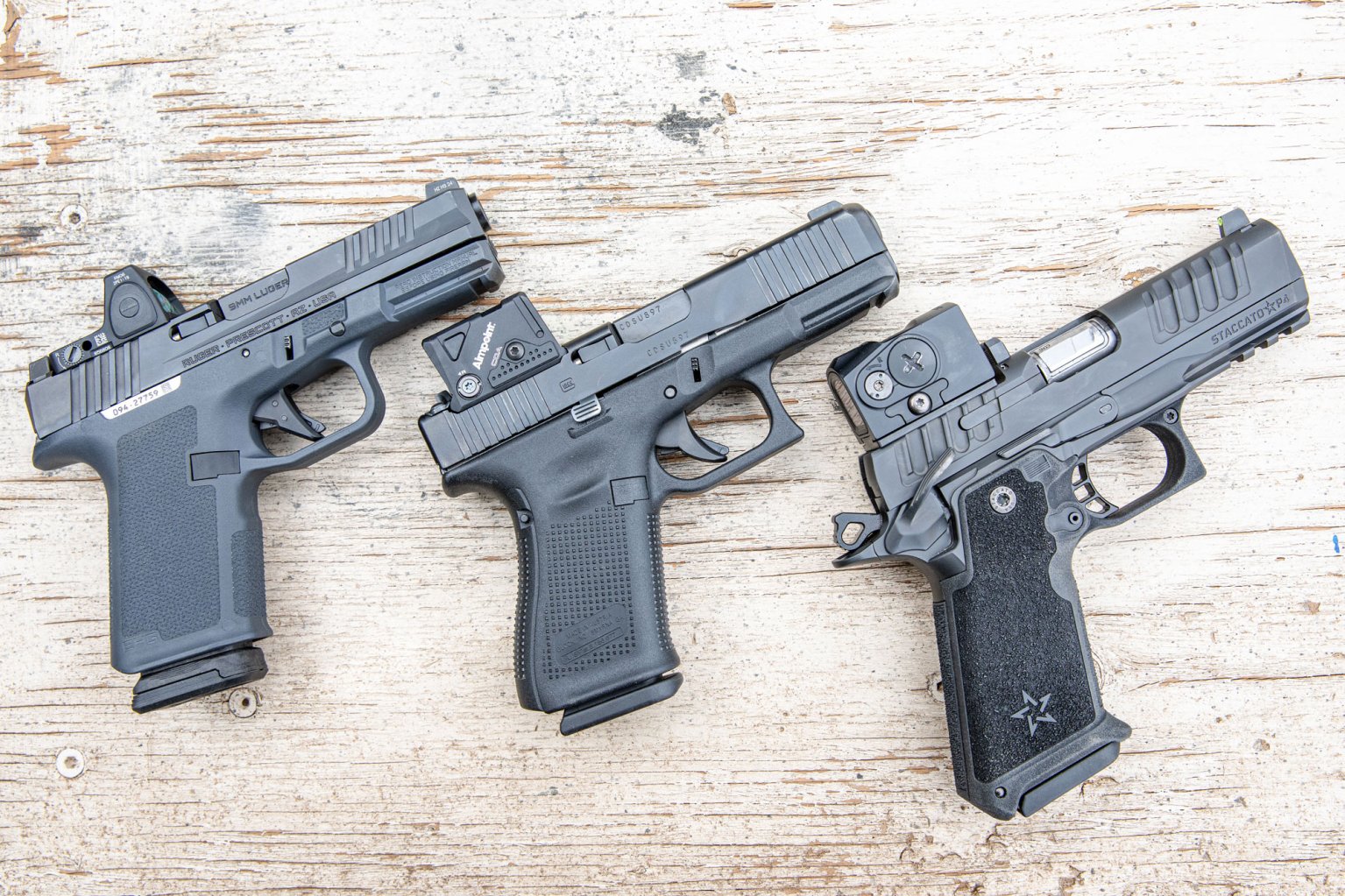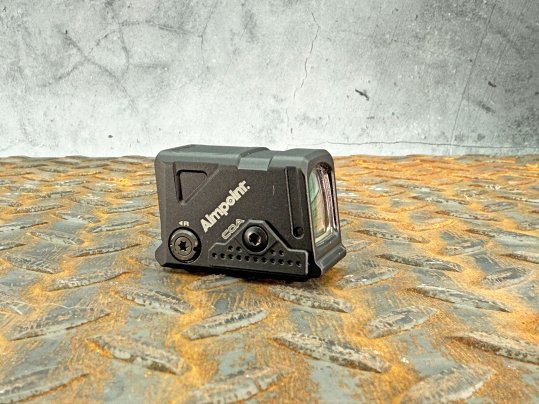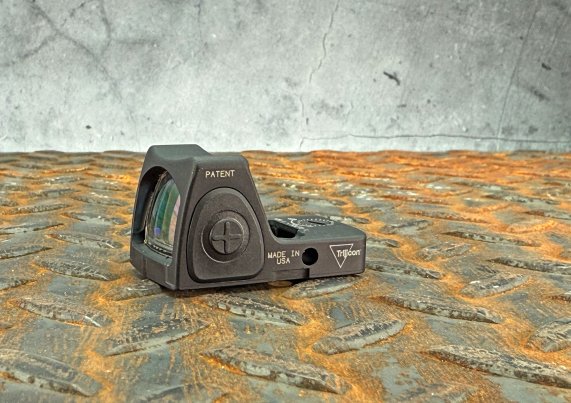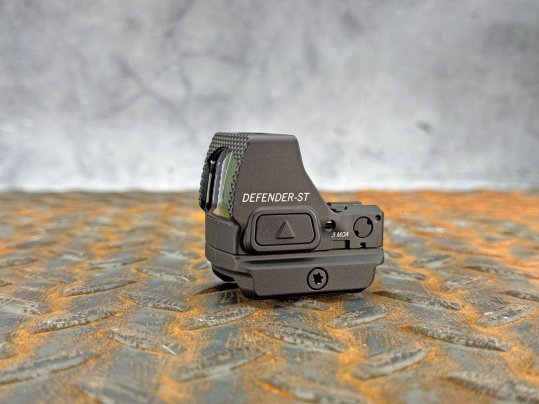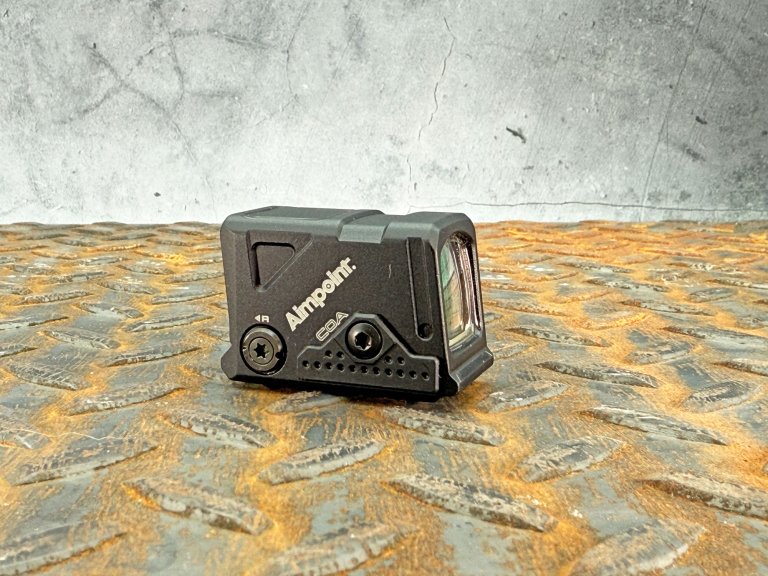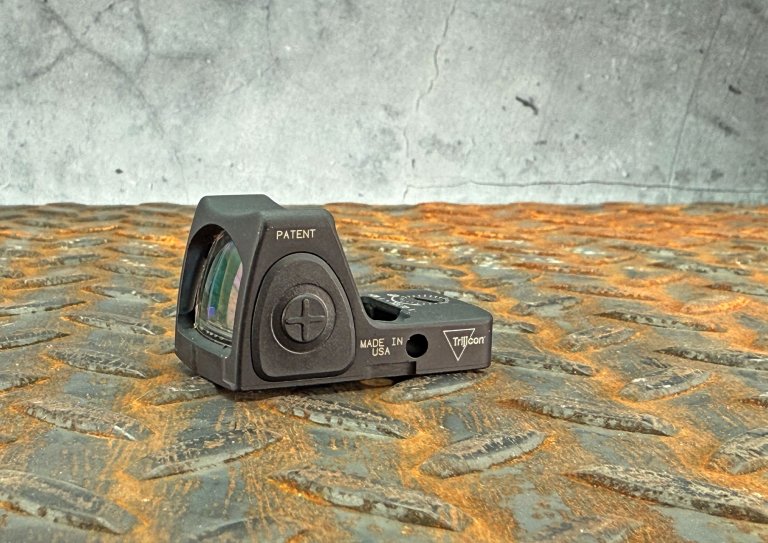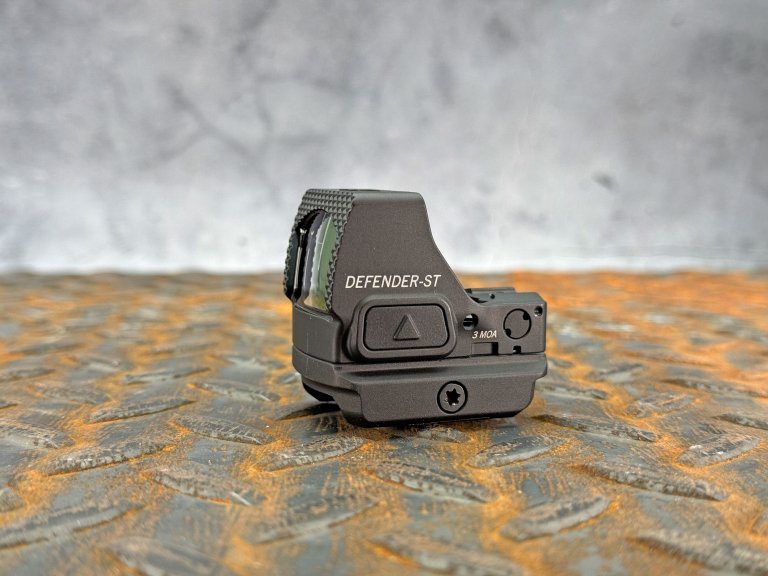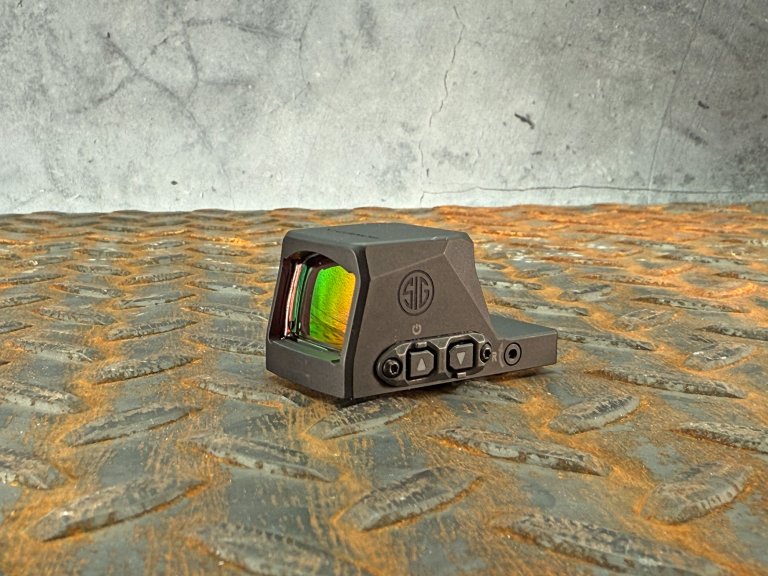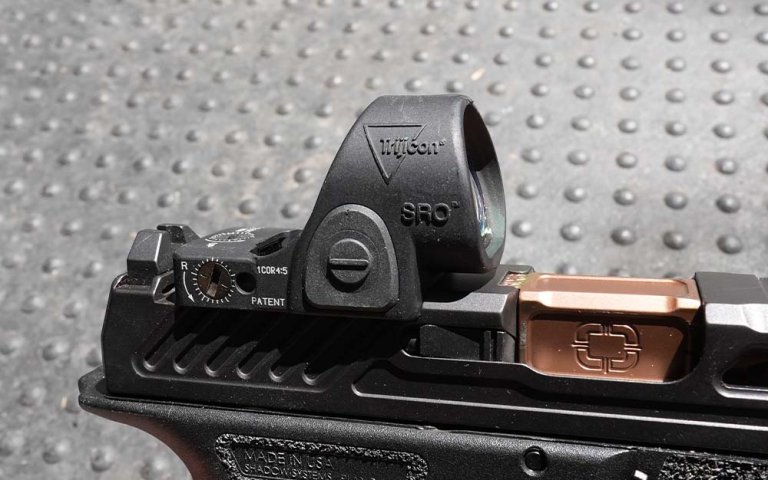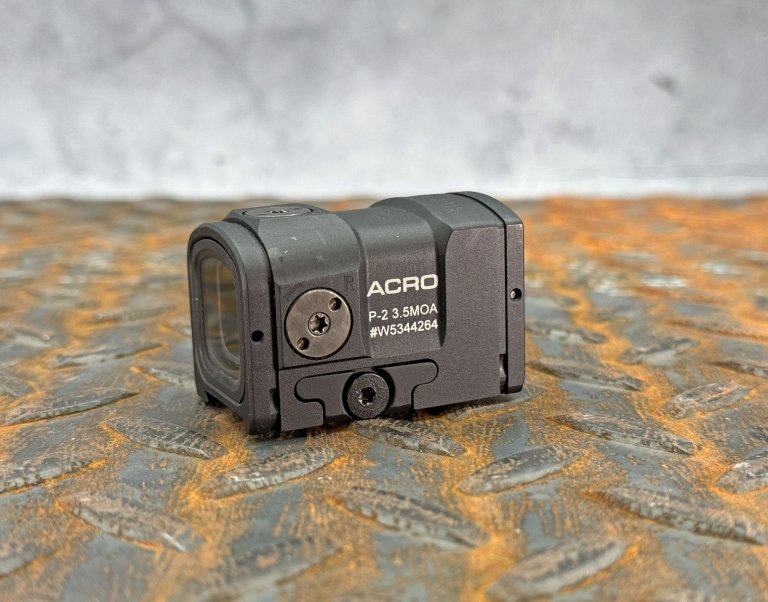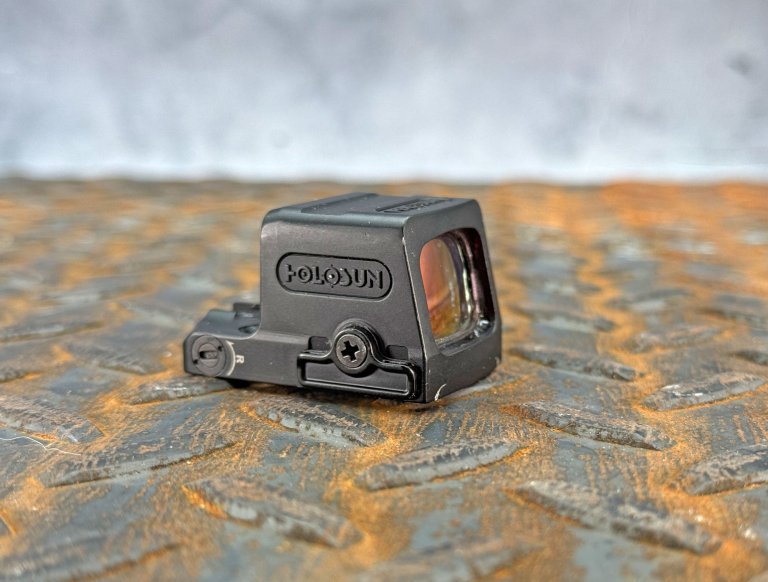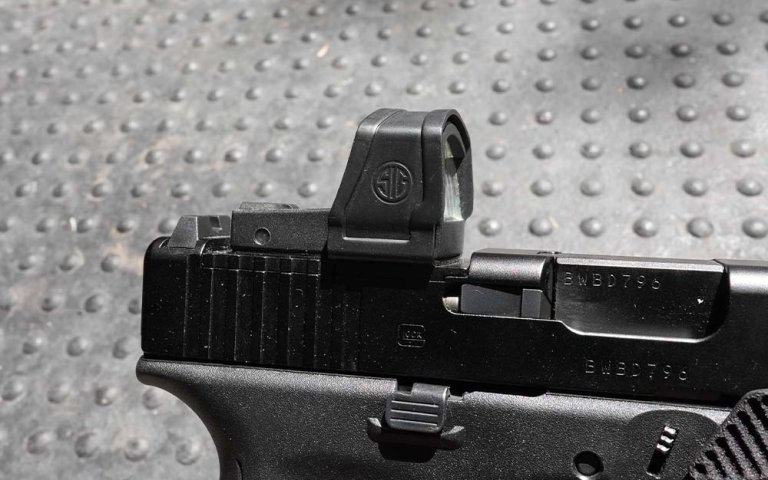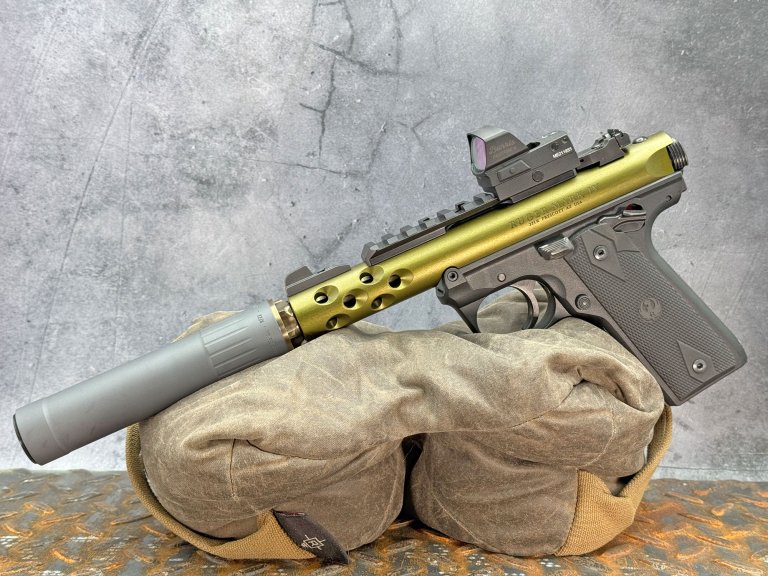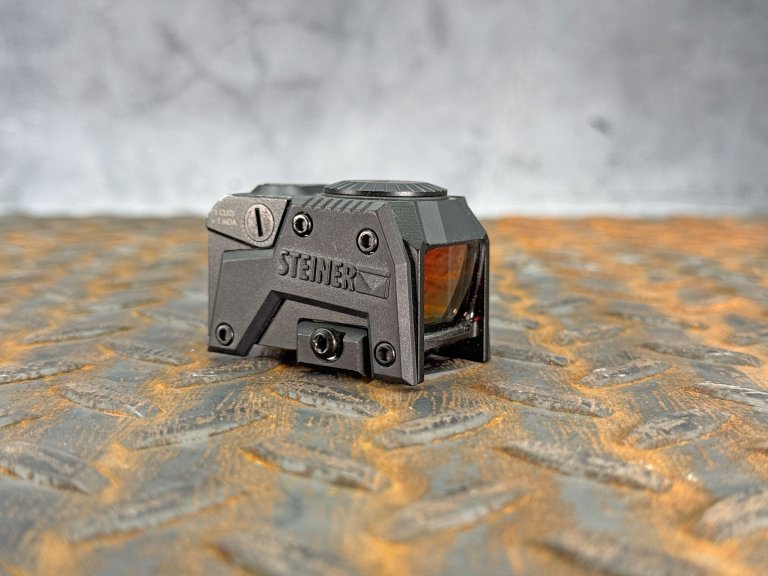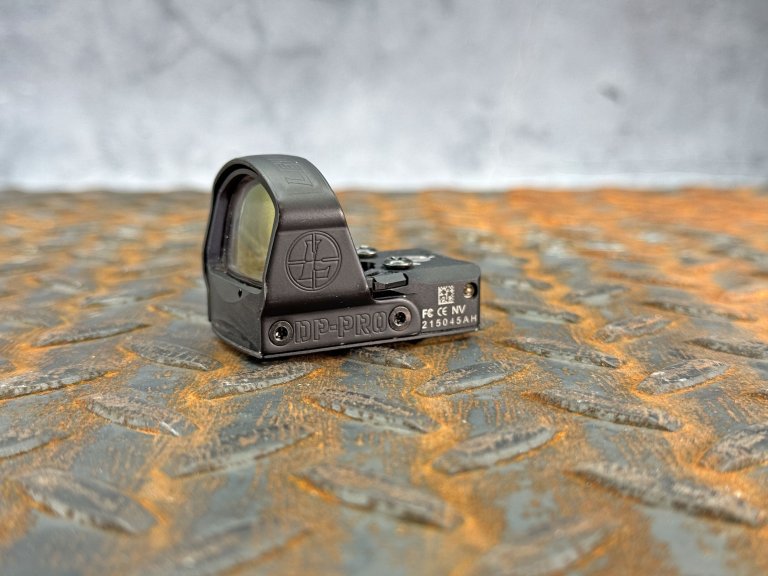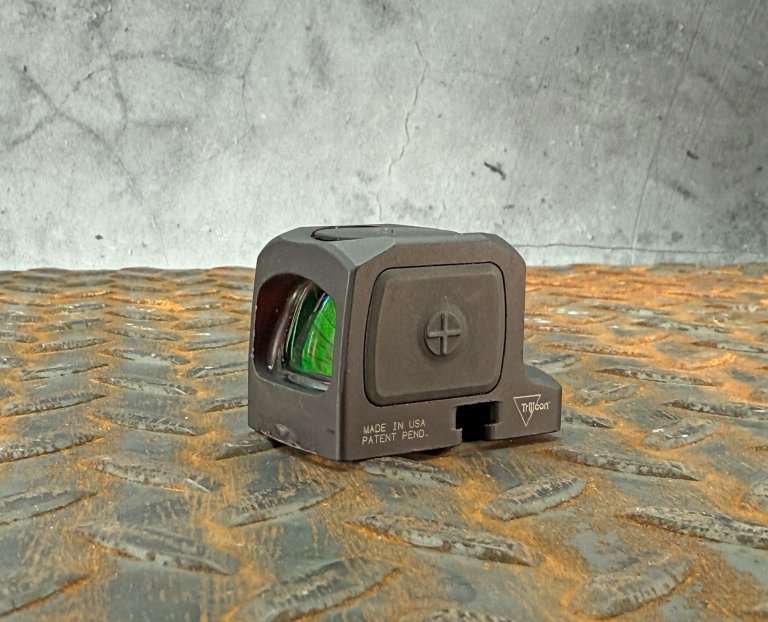We may earn revenue from the products available on this page and participate in affiliate programs. Learn More ›
Not long ago, pistol red dots weren’t much more than a novelty or niche competition tool. Today they are the standard. Red dot reflex sights help us shoot pistols faster and more accurately, and we now have options for every application. Shooting editor John B. Snow and I have tested many of the best pistol red dots and have compiled this list to help you find what works for you.
- Most Innovative: Aimpoint COA
- Best Overall: Trijicon RMR Type 2
- Best Value Red Dot: Vortex Defender ST
- Best for Concealed Carry: Sig Sauer RomeoX Enclosed
- Best for Competitive Shooting: Trijicon SRO
- Aimpoint ACRO P-2
- Holosun EPS Carry
- Sig Sauer Romeo Zero Elite
- Burris Fastfire 4
- Steiner MPS
- Leupold DeltaPoint Pro
- Trijicon RCR
Best Pistol Red Dots: Reviews & Recommendations
Most Innovative: Aimpoint COA
Pros
- Durable
- Sits low on slide
- Solid connection system
Cons
- Only available as package with Glock pistols
Key Features
- Weight: 1.7 ounces
- Footprint: A-Cut
- Objective Lens Size: .65 x .59 inches
- Reticle: 3.5 MOA dot
- Adjustment: 12 brightness settings, +/- toggle buttons
- Battery: CR2032

Aimpoint’s new COA red dot is an innovative sight that has nearly everything we want in a pistol red dot. It’s an enclosed-emitter sight, which means that the reticle projection is fully sealed and protected from disruption by moisture or debris. Despite being larger than most open-emitter sights, the COA’s housing has slender sides that aren’t too disruptive to the sight picture.
The most innovative part of the COA is its footprint — how it attaches to the pistol. Different optics have different mounting footprints and methods, but the new A-Cut design of the COA is one of the best we have seen. Instead of screws that pass through the optic and fasten it to the slide or an adapter plate, the COA fits into the A-Cut like a ski boot. A lip at the front fits into a notch, then the rear of the sight drops onto the slide. The rear of the COA is held in place by the rear sight, which doubles as a wedge to hold it securely. This reduces stress on the screws and allows the COA to sit lower than other optics.
Because it sits low, standard sights can be co-witnessed through the COA. It uses T10 torque screws to zero windage and elevation, and brightness settings can be toggled with the +/- buttons on the side. It’s a durable sight that’s great for concealed carry and general red dot applications. The only downside is that, for now, it’s only available as a package on certain Glock pistols. I believe more will adopt this new A-Cut when the one-year embargo ends. If you want to learn more, check out our in-depth story on the COA. –TF

Best Overall: Trijicon RMR Type 2
Pros
- Built for hard use
- Good ergonomics
- Great engineering
Cons
- Expensive
Key Features
- Weight: 1.2 ounces
- Footprint RMR
- Objective Lens Size: .83 x .63 inches
- Reticle: 1, 3.25, or 6 MOA dot
- Adjustment: Eight settings, two for night vision
- Battery Life: Four years
- Battery: CR 2032
The Trijicon RMR Type 2 is one of the most iconic and dependable pistol red dots in the world — certainly at the top of the heap of open-emitter designs. The Trijicon RMR Type 2’s distinctive features set it apart from the rest of the field and justify its lofty price tag.
The RMR sights have a couple of distinctive features compared to the rest of the field. One is the drain holes on either side of the housing that keep water and other debris from collecting around the emitter. The other is the curious shape of the housing, with its concave top which boosts impact resistance.

There are a couple dozen different variants of the Type 2 to pick from with various mounting systems and dot sizes. It can be had with 1, 3.25, or 6.5 MOA dots. Mine, a 3.25 MOA dot, is bright and crisp. The unit has minimal optical distortion (though the glass does have a noticeable blue tinge), eight brightness settings to pick from (including two for night vision), and a four-year run time from a CR 2032 battery. If desired, the sight can be set to an automatic mode that adjusts reticle brightness based on ambient light.
If you’re looking for a pistol or small arms sight that can do it all—personal protection, concealed carry, target shooting, hunting — the RMR Type 2 is it. –JBS
Best Value: Vortex Defender ST
Pros
- Big sight window
- User-friendly controls
- Easy sight-in
Cons
- Battery cap can’t be removed with straight driver, requires tool
Key Features
- Weight: 1.48 ounces
- Footprint: RMR
- Objective Lens Size: .84 x .71 inches
- Reticle: Red or green dot, 3 MOA
- Adjustment: 10 settings, up/down buttons
- Battery: CR2032
The Vortex Defender ST is an excellent value and a great choice for a multi-purpose pistol red dot. It uses the Leupold Deltapoint Pro footprint and is attached with two screws. It has a large window which helps with fast dot and target acquisition, and is available in both red-and green-dot form. The robust protective aluminum housing around the lens has course pyramidal knurling at the front, which provides grip for using the sight to rack the slide.
The Defender ST has large up/down buttons on each side for adjusting brightness between 10 settings, including two for use with night vision goggles. Windage and elevation are tuned via flat-bit screws, and the only thing. we aren’t a big fan of is the battery cap. Its location requires the use of an included wrench to remove and install without damaging the cap or sight housing.
Larger and smaller versions of the Defender are available, but the ST is a great all-around choice. –TF

Best for Concealed Carry: Sig RomeoX Enclosed
Pros
- Low profile
- Large sight window
- Multiple reticles
Cons
- Windage and elevation require small T5.5 Torx bit
Key Features
- Weight 1.1 ounces
- Footprint: RMS, Shield
- Objective Lens .77 x .6 inches
- Reticle 3-MOA dot, 6-MOA dot, or circle dot
- Adjustment 15 settings, up/down buttons
- Battery CR1632
The Sig Sauer RomeoX Enclosed is one of the most shooter-friendly red dots — especially for a compact concealed-carry gun. It has a low profile and is much smaller than many other enclosed-emitter sights, but a generously-sized window.
The RomeoX has a durable aluminum housing and a rear lens to keep debris and moisture from disrupting your sight picture. It features 15 brightness settings which are toggled via up/down arrow buttons on the left side. To preserve battery life, the RomeoX uses Sig’s Magnetac magnetic activation to shut the sight off when holstered and activate it when removed.
Our favorite thing about this sight, in addition to the large window, is the reticle selection. The shooter can pick from three-MOA, six-MOA, and circle dot reticles. The circle dot is excellent and features a small center dot with a large halo. This large reticle is very fast to acquire and track while shooting, and the small center dot allows more precise shot placement. –TF

Best for Competitive Shooting: Trijicon SRO
Pros
- Generous sized objective lens
- Great ergonomics
- Tough
Cons
- Spendy
Key Features
- Weight: 1.6 ounces
- Footprint: RMR
- Objective Lens Size: 26mm
- Reticle: 1, 2.5 or 5 MOA dot
- Adjustment: Eight brightness levels, two for night vision
- Battery Life: 3 years
- Battery: CR 2032
Looking through the Trijicon SRO is like staring out of a large picture window with mountain views. It’s a thing of beauty. The generously sized objective lens measures 26 mm in diameter making it easy to find and reacquire the dot during rapid shooting. That quality is a big part of the reason why the SRO is my top choice for competition. In addition to that is the durable construction and top-notch engineering of all Trijicon’s best pistol red dots.

The SRO is offered with three sized dots depending on your needs: 1 MOA, 2.5 MOA, or 5 MOA. I opted for the 2.5 MOA model, which strikes a great balance between size and precision and handles any shooting chore well.
For a larger sight, the SRO manages to sit relatively low on the slide. That makes sighting through the window that much faster and helps the sight co-witness with irons more easily.
The SRO has a tiny bit of optical distortion, but not enough to detract from the sight’s performance. In fact, with its large objective lens, the SRO handled tracking and target transitions better than any other red-dot in the test.
The ergonomics on the unit are fabulous as well. The windage and elevation adjusters have medium-sized slots that can accommodate a regular screwdriver bit or thin coin and offer positive feedback with each click. The sight has 150 MOA of w/e travel with each click moving the sight 1 MOA. The battery tray is easy to access and doesn’t have to be removed from the pistol when putting in a new one. –JBS
Aimpoint ACRO P-2
Pros
- Extremely rugged
- Great optical clarity
- Excellent ergonomics
Cons
- Pricey
Key Features
- Weight: 2.1 ounces
- Footprint: RMR
- Objective Lens Size: 15x15mm
- Reticle: 3.5 MOA dot
- Adjustments: 10 settings, four for NV
- Battery: CR 2032
When I was putting together a new handgun for bear protection, I topped it with this sight. The Aimpoint ACRO P-2 checks all the boxes I need and excels in terms of reliability and survivability.
The main virtue of an enclosed emitter is that it is protected from the environment. I spend a lot of time in grizzly country, both in the mountains and in low-lying river bottoms. Between the snow that’s typical at elevation and the mud and debris that’s part of any river system, there are a lot of ways for a red dot to get clogged with gunk. The ACRO P-2 has flat windows on either side of the unit that can easily be wiped with a shirt sleeve to clear the glass.
The 3.5 MOA dot has round, crisp edges, though when the intensity level is jacked up to the max (there are 10 settings, four of which are for night vision), the dot has a fair bit of blooming. On the plus side, there isn’t any lighting situation where the ACRO’s dot will wash out. The buttons that control the dot intensity give very positive feedback, which allows them to be manipulated while wearing gloves.
The optical clarity of the unit is among the best in the field. There is very little color distortion and no optical distortion while looking through the sight. Picking up the dot and recovering it while shooting is a snap. It is very forgiving.
All this performance, however, comes at a cost. The ACRO P-2 is among the most expensive red dots out there, but it is a serious professional-grade tool that is well worth it. –JBS
Holosun EPS Carry
Pros
- Bright, crisp dot
- Easy to change battery
- Good option for concealed carry or turkey gun
Cons
- Can bloom if setting is too bright
Key Features
- Weight: 1 ounce
- Footprint: RMS Shield
- Objective Lens: .75 x .56 inches
- Reticle: 2-MOA, 6-MOA, or circle/dot
- Adjustments: 8 brightness settings, +/- buttons
- Battery: CR1620
The Holosun EPS Carry mounts on guns with RMSc, Holosun K, Leupold DeltaPoint Pro, and Sig Sauer RomeoZero optic cuts or mounting plates. It comes with screws of various lengths (use the longest that will work) each with Blue Loctite already on them. Holosun recommends torquing the screws to 15 inch-pounds.

The battery door is located on the right side of the optic and is accessible without removing the red dot. Holosun says the battery life is 5,000 hours, which is about 200 days. It’s not the five-year battery life of the Holosun 507 K, but changing a battery once every six months is still pretty damn good.
The 6 moa dot on my EPS Carry is crisp and round. This is exactly how a dot should look, but many red dot sights come up short in this feature. The EPS Carry’s glass has a slight blue hue, which is common on red dots. -Scott Einsmann
Read the full Holosun EPS Carry review to learn more about the optic and see how it held up against the Trijicon RMR in a down pour.
Sig Sauer Romeo Zero Elite
Pros
- Lightweight
- Good value
Cons
- Inconvenient control button
Key Features
- Weight: 0.5 ounces
- Footprint: Shield RMS
- Objective Lens Size: 20mm
- Reticle: 3 MOA dot
- Adjustment: Eight settings
- Battery Life: 20,000 hours
- Battery: CR 1632
I’ve been running a Romero Zero Elite on a Glock 19 for a while now and it has stood up to some rough use and a lot of rounds.
It’s a basic unit with a 3 MOA dot with eight brightness levels. It’s also offered with a 2 MOA dot within a 32 MOA circle for those who want a larger reticle. A small button just behind the objective lens controls the unit. While unobtrusive, the button is a little hard to reach, especially if you have sausage fingers, and a bit of a pain to manipulate. If my fingers were dirty—from doing a lot of shooting, say—I had difficulty adjusting the brightness without getting a greasy smear on the inside of the objective lens. Not a deal killer by any means, but it is pesky.
Other than that, I had no complaints with the Romeo Zero Elite. The optical quality of the sight is pretty good. It has a metal shield you can install to give the polymer-framed unit more protection if you like. The zero is easy to adjust via the recessed windage and elevation controls that use a tiny hex key wrench.
Another thing in its favor is its affordability. It’s one of the best red dots for the money. With a CR 1632 on board, it delivers up to 20,000 hours of run time. –JBS
Burris Fastfire 4
Pros
- Multiple reticles
- Versatile design
Cons
- Some optical distortion
Key Features
- Weight: 1.7 ounces
- Footprint: Docter
- Objective Lens Size: 27x18mm
- Reticle: Four user-selectable options
- Adjustment: Three brightness levels
- Battery Life: 26,000 hours
- Battery: CR 1632
With the push of a button on the side of the unit’s housing, you can cycle through four reticles. The reticles include a 3 MOA dot, an 11 MOA dot, an 11 MOA dot surrounded by a 50 MOA circle, and a 3 MOA dot surrounded by a 50 MOA circle with the addition of two “wings” that effectively form a horizontal crosshair.
Each of these reticles has useful applications. The 3 MOA dot is good for precise shot placement and general handgun use. The 11 MOA dot is good for bright lighting conditions and would work well for turkey hunters and slug-gun hunters. The 11 MOA with a circle is good for personal defense and CQB scenarios, and the 3 MOA circle with wings can handle close and mid-range shooting. It can also be a good option for wingshooting as well. The intensity of these reticles is controlled by a button on the left side of the unit, which has three levels of brightness.
As the late-night TV pitchmen say, but wait, there’s more! The Fastfire 4 is also the only sight in this roundup that converts from an open to closed emitter design. It comes with an environmental shield that screws on to the back of the unit and encloses the emitter. While this won’t make the Fastfire waterproof against submersion, it will prevent rain, snow and dirt from clogging the LED.
The wide objective lens makes reticle acquisition easy, but the glass does have noticeable optical distortion. –JBS
Steiner MPS
Pros
- Rugged
- User friendly
Cons
- Can be tricky to mount on different platforms.
Key Features
- Weight: 2 ounces
- Footprint: ACRO
- Objective Lens Size: 20x16mm
- Reticle: 3.3 MOA dot
- Adjustment: Eight levels, two for night vision
- Battery Life: 13,000 hours
- Battery: CR 1632
The Steiner MPS is arguably the sexiest pistol reflex sight out there. It has head-turning futuristic lines that visually set it apart from this crowded field of the best red dot sights. For that reason, any gun owner who values the aesthetic impact of their gun will want to consider the MPS.
But this sight is more than a pretty face. It’s a rugged and capable enclosed emitter with user-friendly ergonomics and a distortion-free sight picture. And, while not cheap, it runs about $100 less than the Acro P-2, so it has that going for it as well.
The 3.3 MOA dot is round and crisp—one of the sharpest in the test. The MPS has eight brightness settings on tap (two for night vision), that are actuated by the “+” and “-” buttons on the unit’s left side.
The MPS’s battery compartment sits on top of the metal housing and takes a CR 1632 battery that provides enough juice for 13,000 hours of run time. To conserve battery life, the MPS automatically shuts down after 13 hours.

To enhance the MPS’s survivability, Steiner added two beefed-up panels on either side of the sight and recessed the objective lens in the housing. With this added degree of protection, the sight only weighs 2 ounces.
The slot-head POI adjusters give excellent feedback with each click. The unit has 90 MOA of travel in both windage and elevation with each click moving the dot 1 MOA.
The MPS fits an ACRO footprint and comes with a Docter adapter plate. Plates for other mounting patterns are available as well. –JBS
Leupold Deltapoint Pro
Pros
- Excellent optical quality
- Large, bright aiming point
- Convenient battery compartment
Cons
- Expensive
- Sits high on the pistol
Key Features
- Weight: 2 ounces
- Footprint: Deltapoint Pro
- Objective Lens Size: 20mm
- Reticle: 2.5 MOA
- Adjustment: 8 settings
- Battery: CR 2032
Like all Leupold DeltaPoint’s, this model is wonderfully engineered. The toolless battery compartment/adjustment button is convenient and clever. Pushing on the button allows the shooter to cycle through eight different brightness settings.
The coin-slot windage and elevation adjustments have 60 MOA of travel. They adjust in 1 MOA clicks and give excellent tactile feedback when turned. The battery life figures that Leupold gives are much lower (and more realistic, to be honest) than you’ll see with other sights, but it’s worth keeping the dot brightness to a lower setting or making a point to turn off the sight when not in use to get more from the battery.
To harden the sight, Leupold encloses it in a metal shield that wraps over the optic. This bumps the weight to 2 ounces, making it one of the heavier open-emitter sights in the test. The Deltapoint Pro is very popular and still one of the best sights out there. However, it’s rapidly being overtaken by smaller enclosed-emitter sights that sit lower on the pistol. We hope to see some updates in the coming years. –TF
Trijicon RCR
Pros
- Very rugged
- Large control buttons
- Easy windage and elevation adjustment
Cons
- Proprietary screws can come loose
Key Features
- Weight: 1.9 ounces
- Footprint: RMR
- Objective Lens Size: .93 x .63 inches
- Reticle: 3.25-MOA dot
- Adjustment: 10 settings, +/- buttons
- Battery: CR2032
The Trijicon RCR is an even more ruggedized version of the RMR, with an enclosed emitter. This sight takes what is great about the RMR and makes it even more durable and dependable. It features a blocky but tough aluminum housing with a recessed front lens that is protected from incidental impact or from using the sight to rack a pistol slide on a hard surface. It has a generously sized window and large +/- buttons on either side to adjust brightness.
The only drawback I’ve encountered while using the RCR on various pistols is that without appropriate torque and thread locker, the screws tend to loosen. To allow the same bolt pattern, special screws are used to attach the RCR. The screw heads have holes and are tightened by using a small tool or punch to turn them. A nice thing about the design is that you won’t strip screw heads out and it helps prevent over torquing. –TF
How to Choose the Best Pistol Red Dot

When you’re shopping for a pistol red dot, you’ll likely feel overwhelmed with the choices you see. Fortunately, with some consideration, you can sort through a few qualifiers that will narrow the field and help you pick the best pistol red dot for your application.
What’s Your Intended Use?
The most important thing to consider when choosing a red dot is the specific job you need your pistol red dot to do. Is it for competition, hunting, carry, or something else? For competition, you might want a big red dot with a wide field of view. In the case of your carry gun, size and durability will be more important. For 10mm bear defense pistols, you want a rugged optic that will hold up to recoil. In some environments, an enclosed-emitter red dot might be a better choice than an open-emitter sight. Sometimes it might not matter.
What Pistol is it For?
A frustrating part of selecting a pistol red dot is sorting through the various mounting footprints and adapters. There isn’t a universal standard for optic footprints and mounting screws, and it can seem pretty complex. There are commonly-used mounting footprints like the RMS/RMSc, Docter Noblex, and RMR standards, but some are entirely unique.
Often, your pistol will dictate which optics you can use. Some pistols that come optics-ready are only compatible with certain optics. Other pistols have adapter plates for a variety of optics available. Do your homework beforehand because your pistol choice can eliminate some of your red dot options.
Adjustability and Battery Life
Most pistol red dots have good battery life and will run for six months to a year off a CR2032 or CR2016 battery. Plan on changing batteries at least once a year as a matter of practice, but note how the batteries are changed. Although many sights have easy battery access, some need to be fully removed to change the battery. Some sights will shut off automatically when left sitting still, and others will stay running no matter what. Look at a few of them, and you’ll notice that many have adjustable brightness settings, and some adjust automatically. Buy what suits your needs best, but try to look at the sights in both dark and bright conditions. I’ve found some sights to be difficult to see in bright sunlight.
FAQs
No. You don’t need a red dot on a pistol to shoot accurately and effectively; but pistol red dots can greatly improve your speed and accuracy. Some people will still prefer iron sights, so try shooting pistols with different red dots before you buy one.
Each pistol red dot is a little different; but use the same process for zeroing any of them. After mounting the red dot, fire a single shot from a supported position at 5, 10, or 15 yards. If your shot isn’t on paper, move closer and try again. If you can see your impact, adjust the windage and elevation (horizontal and vertical) to move the bullet impact closer to the dot. Fire, adjust, and repeat until you’re zeroed, then fire a group to confirm.
Many shooters find pistol red dots to be worth the cost, and can shoot them more quickly and accurately than iron sights. They’re durable and dependable, and priceless to those who don’t have perfect vision.
The best dot size depends on your application. 2.5- to 3.5-MOA dots are most common, but dots with larger circle reticles are effective for fast shooting at close range.
Final Thoughts
A jam-packed field makes sorting through pistol red dots an intimidating task, but it also provides a lot of options. Even on a meager budget, you can likely find a sight that will fulfill your needs. There is no single best pistol red dot sight, but there’s a hell of a lot of good ones. If you consider your application, your particular pistol’s mounting options, and the features you prefer, you can find the right one for you—and you’ll probably never look back.
